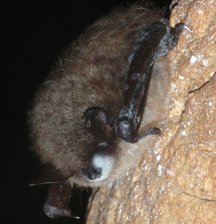
 Department of Conservation and Recreation
Department of Conservation and Recreation
Conserve. Protect. Enjoy.
 Department of Conservation and Recreation
Department of Conservation and Recreation
First documented in upstate New York in 2006 and arriving in Virginia in 2009, White-nose Syndrome(WNS) is a fungal disease that infects the skin and subcutaneous tissue of bats during hibernation. In addition to damaging tissue, the infection arouses bats from hibernation, causing them to burn up precious fat reserves.

From 2009 through 2013, WNS spread across western Virginia killing large numbers of bats that hibernate in caves. Little brown, tricolored, and northern long-eared bats were all heavily impacted with mortality estimates exceeding 95%. While northern long-eared bats are rarely seen in the aftermath of the WNS wildlife pandemic, little brown and tricolored bats persist and appear to be slowly increasing in number.
Avoiding the disturbance of hibernating bats in the winter and of summer maternity colonies in barns and attics are two of the best ways to help bat populations recover. In addition, if you visit a Virginia Cave you should assume that you may be contaminated with the spores of the fungus (Pseudogymnoascus destructans) that causes WNS. While WNS is widespread across north America, it is still important to avoid transporting spores to the places where WNS is not pervasive in caves like it is in Virginia. To learn more about WNS and how you can help stop the spread, visit the Fish and Wildlife page.
Links to more information on white nose syndrome:

